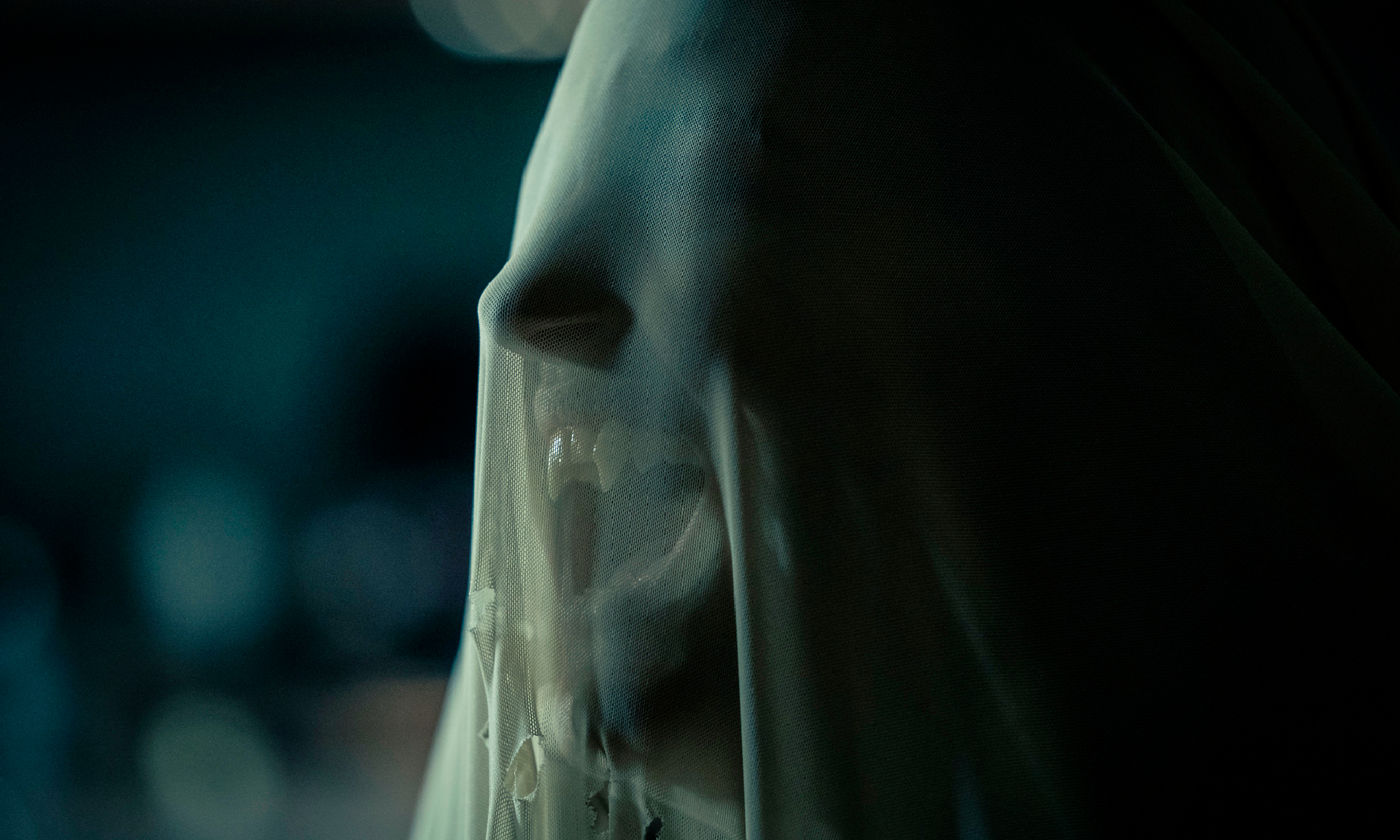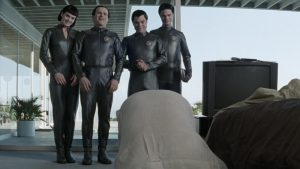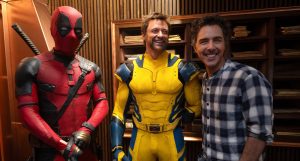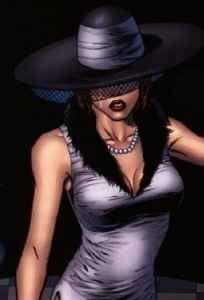
Is the third time the charm for Salem’s Lot? Stephen King’s iconic 1975 novel about a small Maine town overrun by vampires (his second published book, and still widely regarded as one of his masterpieces) has now been filmed three times: as a three-hour (minus commercials) 1979 miniseries directed by Tobe Hooper, another miniseries of the same length, directed by Mikael Salomon in 2004, and now a 114-minute feature film adapted and directed by Gary Dauberman.
Dauberman came to Salem’s Lot with his horror and Stephen King bona fides already in place too. He wrote the three Annabelle movies (the third of which, Annabelle Comes Home, he also directed) and The Nun for James Wan’s Conjuring universe, but more importantly, he scripted the 2017 and 2019 feature films based on King’s It, a sort of dry run at a familiar King narrative in which a more or less isolated town in rural Maine is beset by a powerful supernatural entity.
It, however, was broken up into two films and (like the book) largely focused on the seven characters who make up the Losers’ Club. Salem’s Lot has always posed a different problem: while the book does eventually focus on a band of main survivors who become the story’s de facto vampire hunters, it spends a lot of pages allowing the reader to get to know the residents of the Jerusalem’s Lot, the full name of the novel’s titular town. You spend time with everyone, from the local innkeeper to the disabled curmudgeon who runs the town dump. It’s that familiarity with the townspeople—their petty squabbles, affairs, and other gossipy subplots—that allows the reader to feel like we know them, making their ultimate transformation into creatures of the night even more ghastly.
It’s a challenge that dogged not just the makers of the book’s two previous adaptations, but even filmmakers going back to the late 1970s who tried to turn the book into a feature film. And it’s the same test that Dauberman faced as well. “There’s so much great stuff. It’s like, what do you have to weed out?” he says when we sit down for a Zoom interview. “An audience’s attention span only goes so long. There are a lot of great side stories and B-stories in this book that I love, and it was hard to let those go in order to give more real estate to our core group of heroes. That was probably the biggest challenge—editing the story, and then figuring out those repercussions and those ripple effects into the main storyline.”
What’s Gone and What’s Stayed in Salem’s Lot
Dauberman reveals that his initial cut of the film, which included more of the town’s backstory, was significantly longer.
“My first cut was about three hours,” the filmmaker confirms. “There’s a lot left out. My first draft of the script is 180-odd pages or something because you’re trying to include everything. And a lot of it has to do with a lot of the secondary characters and stuff that I spoke about. So it was sad to see that stuff go, but it’s like a necessary evil.”
One of the most difficult things that Dauberman let go was an incident that occurs in the past of writer Ben Mears (Lewis Pullman), when as a child he sneaked into the Marsten House—the abandoned mansion that broods over Salem’s Lot—and had what may have been a supernatural experience.
“In the book, Ben sneaks into the Marsten House and he sees the ghost of Hubert Marsten,” the director explains. “I shot that and it used to open the movie, but it seemed to muddy the waters for audiences; the ghost story within the vampire story. To me it’s so important because it’s why Ben believes the vampire stuff, but we’re not telling that story, so that was the hardest thing to cut because I love the sequence.”
While Dauberman did pare down his story to just under two hours (and there’s no indication yet on whether a director’s cut could surface in the future), his Salem’s Lot does include a number of iconic sequences from the book. Among those are the capture of the Glick brothers by the vampire Barlow’s human henchman, Straker (Pilou Asbæk), grave digger Mike Ryerson (Spencer Treat Clark) being compelled to open Danny Glick’s (Nicholas Cravetti) coffin, Danny’s spectral appearance at the window of young monster hunter Mark Petrie (Jordan Preston Carter), among others.
The film also retains the blossoming romance between Ben and local girl Susan Norton (Makenzie Leigh), as well as the main characters assembling to confront and destroy Barlow (Alexander Ward). “I love all that,” says Dauberman. “Those were the kind of scenes that we were not going to touch.”
Making Vampires Scary Again
As for the vampires themselves, as more townspeople are turned into bloodsuckers with each passing day, Dauberman wanted to move firmly away from the sexually charged “hot vampires” of recent years seen in films and series like Twilight or Interview with the Vampire.
“I kind of wanted to take a classic approach because I hadn’t seen a classic approach in a while,” he says. “I thought about the way that James [Wan] approached The Conjuring where it felt like a very classically told haunted house story, but it felt fresh at the time because we hadn’t seen that in a long time. That was my approach to vampires here. It’s what the book is. It’s Dracula set in small town America. I wanted to be true to that spirit.”
When it came to Barlow, the ancient vampire that sets the fall of Jerusalem’s Lot in motion, the European nobleman of King’s novel was transformed into a Nosferatu-like creature for the 1979 adaptation, before the late Rutger Hauer walked the character back toward the King interpretation for the 2004 miniseries. Although Dauberman says he initially took more of the latter approach, presenting Barlow closer to what he was in the book, that “ate up a lot of real estate,” as he describes it.
“I kept going back to the ’79 version,” Dauberman says about his eventual solution. “I have a Barlow action figure from the ’79 version and I kept going back to that. I had long talks with James [Wan] about that, the creature version vs. the Dracula-esque version of Barlow. We started to explore some designs and got excited about the designs and stuff, so I sort of just naturally gave myself over to the more creature-like version of Barlow than the European nobleman side.”
Why We Keep Returning to Salem’s Lot
Filmed in 2021 and early 2022, and initially slated to hit theaters in fall of 2022, Dauberman’s film fell prey to the corporate reorganization that sent other Warner Bros. productions like Batgirl and Coyote vs. Acme into oblivion as tax writeoffs. Fortunately, Salem’s Lot has not been banished from sight, even though its theatrical run was canceled in favor of a premiere on the Max streaming service. “It was a long journey,” Dauberman tells Den of Geek about the film’s protracted road to release. “It was a dark journey, you know, mostly an unpleasant journey, just not knowing… I just didn’t know what was going on.”
One person who did provide encouragement to Dauberman during both the filming of Salem’s Lot and its lengthy period in limbo was Stephen King himself. While the legendary author gave Dauberman notes on the script and, later, a cut of the film, he also publicly admonished Warner Bros. Discovery for holding up the release of the completed film while privately supporting its writer-director.
“He’s been doing this forever, so he understands the process of making a movie and what can be achieved, what can’t be achieved, and all that,” says Dauberman. “And it’s really nice hearing from someone who’s gone through it so many times because of the wealth of information and education he’s had over the years in just making these things and watching them. So he had words of encouragement and notes that were really, really helpful in a period of time that was… He was a light in a lot of dark.”
Now that Salem’s Lot is finally about to see the light of day, Dauberman is reflective about what has made King fans (and readers in general) embrace this novel so deeply, himself included, as well as why it still holds the kind of power that keeps filmmakers coming back.
“I think it’s that pervasive fear of something coming into your small town or whatever it is and sort of infecting it,” he says. “From a story standpoint, I think it’s just scary, and the characters are really great and feel really grounded. I love the earnestness of it. It’s a love story, not just between Ben and Susan, but clearly Ben and Mark, and there’s an old-fashionedness to it, and a genuineness to it that I find really refreshing and that I love. It’s not filled with that kind of cynicism that sometimes we see today. It feels classic to me and it felt classic even when it was written.”
Salem’s Lot premieres on Max on Thursday, Oct. 3.
The post Salem’s Lot Director Reveals First Cut of Stephen King Movie Was 3 Hours appeared first on Den of Geek.







